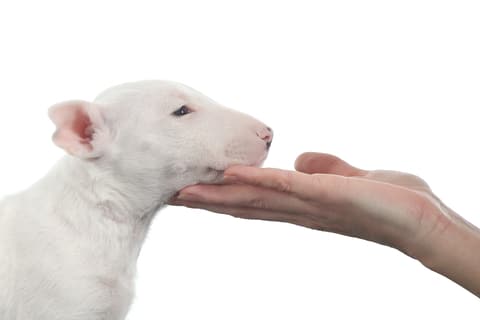Dog Disposition & Personality.

A simple truth: dogs have different dispositions and personalities. This seems so basic it needs no discussion. No one would expect a French Bulldog to have the same personality as a German Shepherd or a Japanese Shiba Inu. It isn’t just that they originated in different countries. They’ve been selectively bred for different purposes, and therefore have different temperaments and personalities.
Recognizing differences and understanding a dog’s temperament yields several benefits and helps us appreciate our dogs. It gives us a foundation for dealing with some differences. And most importantly, appreciation and understanding leads to greater patience.
It is also useful to understand differences to help select the best dog for your family, your home, and your goals for your relationship with your dog.
Here’s some information on the basic components of a dog’s inherent temperament to help us understand what makes our dogs tick. You’ll find asterisk* references to other articles, with a list of helpful links at the end of this article.
Willing or unwilling
Willingness refers to a dog’s “work ethic”—his inherent interest in and motivation to perform a task. A dog willingly performs a task that has intrinsic value to him. If it has none, he’s less eager.
Some tasks are self-reinforcing because of breed propensities—the characteristics for which the breed was originally created. Think about this: It makes sense that a retriever is more “willing” to fetch than say a terrier, bred for finding vermin. For a dog selectively bred with an innate desire to find and bring back birds, retrieving is self-reinforcing. But the terrier has been bred to chase and kill vermin, not to retrieve them. A terrier will likely happily chase a ball, but once he’s got it, his shakes it to death with the attitude, “It’s mine!” This doesn’t mean a terrier can’t be trained to retrieve—of course they can. But it’s accomplished with training, rather than being an inherent predisposition.
Some dogs are thought to be “stubborn.” It’s not stubbornness, rather that there is no intrinsic reward in an activity, so the dog doesn’t have a good reason to do it. After all, what’s in it for the dog to perform this behavior? The solution? Give him a good reason. Provide something that makes it worthwhile for the dog to do it.
It boils down to motivation: What’s in it for your dog? What’s the reward? Training a dog to perform something he wants to do (something self-rewarding) is a piece of cake. But even when an activity is not rewarding in itself, training can be easy. You simply provide a valuable payoff for your dog. With the right motivation, even an unwilling dog will happily cooperate*.
Dependent or Independent
The more independent the dog the less he desires human affection, praise, attention or companionship. The opposite, a dependent dog, craves companionship and attention. Some dependent dogs can be like Velcro—following you wherever you go, even around your home.
Many breeds have been selectively bred to be independent—to perform tasks apart from people. Think about sled dogs pulling a sled, hounds hunting in packs, and herd-guarding breeds left alone for weeks with only sheep for company. These dogs wouldn’t be able to do their jobs if they craved attention from a person.
Again, often called “stubborn,” an independent dog is simply one for whom human attention isn’t as highly rewarding. This doesn’t mean they can’t be trained, or even that they’re difficult to train. Training an independent dog is simply a case of finding a reward more motivating than praise or affection.
Mentally Sensitive or insensitive
Mental sensitivity is the degree to which a dog is affected by our human emotions. A mentally sensitive dog gets anxious and upset when we are express anger, frustration, disappointment, depression or sadness. An insensitive dog is less affected by our moods.
When we are angry, tense or depressed, our dogs may behave differently. You may see expressions of your dog’s feelings (see Body Language). When you see these subtle signals, consider whether your mood is affecting your dog’s mental state.
Most importantly, never take out your frustration or anger on your dog—whether he’s sensitive or not. If you do, your dog will view you as frightening and arbitrary rather than fair and trustworthy. We don’t think this is the kind of relationship you want.
Dominant?
Probably the most misunderstood term in all of dogdom, a “dominant” dog is viewed as challenging the humans to lead the pack. We don’t buy this. All dogs—regardless of whether they appear to be dominant, submissive, or something in between—are merely trying to make their lives as comfortable and pleasing as possible.
Try this on for size. A dog isn’t dominant; he’s pushy. He’s confident. He wants something; he tries for it; he gets it. His success reinforces his pushy behavior. Dog owners often unwittingly reward pushy behavior, inadvertently training a confident dog to be even pushier. Learned, reinforced bratty behavior is then called “dominant.”
Why does it matter? Because this label creates an adversarial climate: “Oh, no! My dog is asserting his dominance. He’s trying to take over. And we can’t have that!” So starts a contentious relationship that negatively affects our feelings toward and our interactions with our dogs—and theirs with us. Sadly, this diminished relationship is all too common.
Don’t misunderstand. We know that having a pushy dog can try the patience of even the most tolerant owner. The good news is that there’s an alternative to the “us-against-them” mindset. Positive training and some simple behavior modification will quickly improve even the brattiest of bratty behavior. Check out our program on Earning Life’s Rewards* For more information about dominance, read about the social hierarchy and pack behavior*.
Subordinate
So what about dog with a subordinate temperament? Submissive dogs often lack self-confidence. They display the body language* of fear and subordinance in an attempt to calm assertive or aggressive behavior. Mentally sensitive dogs often display submissive signals when you get angry or upset. A submissive or fearful dog often benefits greatly from confidence-building activities such as training to provide mental stimulation and participating in dog sports like agility and scentwork.
Energy or Drive
Does your dog tear around the house doing “wheelies?” While not strictly a component of temperament, your dog’s energy level can influence your relationship. Energy level translates to activity level. Just as some people are non-stop while others are lethargic in comparison, so are dogs.
A high-drive dog requires an activity outlet, or her energy will be expended somewhere – anywhere – usually in what people consider behavior problems. Some less-than-desirable energy outlets are destructive chewing, digging, barking, and pestering behavior.
While it would be ideal if a dog’s energy requirements were well matched with her human’s, this isn’t always the case. But mismatches are not hopeless. Owners of high-energy dogs simply have to find a healthy outlet for the dog’s vigor. If you’re active, include your dog in your daily run or throw a ball or bumper for him until he’s tired. Other ideal outlets for energetic dogs include activities such as agility, scentwork, doggie daycare and, of course, training.
If your dog’s behavior is causing a problem, we can help.*
*Reference Links:







